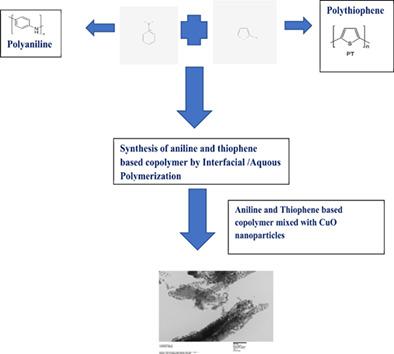当前位置:
X-MOL 学术
›
Polym. Compos.
›
论文详情
Our official English website, www.x-mol.net, welcomes your
feedback! (Note: you will need to create a separate account there.)
Preparation and characterization of polyaniline‐ and polythiophene‐based copolymer and its nanocomposite suitable for electro‐optical devices
Polymer Composites ( IF 4.8 ) Pub Date : 2020-09-10 , DOI: 10.1002/pc.25738 Susmita Dey Sadhu 1 , Prem Lata Meena 1 , Jitender Kumar 1 , Juhi Gupta 1 , Sunil Choudhary 1 , Arun Gupta 1
Polymer Composites ( IF 4.8 ) Pub Date : 2020-09-10 , DOI: 10.1002/pc.25738 Susmita Dey Sadhu 1 , Prem Lata Meena 1 , Jitender Kumar 1 , Juhi Gupta 1 , Sunil Choudhary 1 , Arun Gupta 1
Affiliation

|
Doped polyaniline (PANI), doped polythiophene and their copolymers (by interfacial and aqueous polymerization) with monomers at 50:50 ratio has been synthesized and are characterised by X‐ray diffraction (XRD), thermo gravimetric analysis (TGA), Fourier transform infrared spectroscopy (FTIR), and transmission electron microscopy (TEM) measurements. The copolymer synthesized by interfacial polymerization is mixed with copper oxide nanoparticle synthesized chemically in lab at 0.2% loading. XRD measurement showed no peak for PANI and polythiophene, which confirms amorphous structure of the two. However, clear peak for copper oxide nanoparticle at 2θ = 36.45 and multiple peaks for the copolymer (interfacial polymerization) and the copolymer Nanocomposite signifies crystalline structure. TGA results show that the stability of copolymer prepared by interfacial polymerization lies in between the PANI and polythiophene. FTIR spectroscopy confirms that both aniline and thiophene units are present in the interfacial copolymer. Further the monomers are chemically linked in the copolymer (by interfacial and aqueous polymerization). The presence of peak at about 1103 cm−1 confirms the formation of NS bonding by reaction in between aniline and thiophene in the interfacial copolymer. The uniform distribution of nanoparticles in copolymer (interfacial polymerization) matrix have been confirmed from TEM images. The electrical properties of polymers, copolymers and copper oxide Nanocomposite are studied from which it is found that the copolymer have a synergistic effect on the improvement of conductivity when compared with the individual polymers. The 0.2% loading of copper oxide nanoparticles further improves the conductivity of the interfacial copolymer by approximate 15.24‐fold.
中文翻译:

聚苯胺和聚噻吩基共聚物及其纳米复合材料的制备和表征,适用于光电器件
已合成了比例为50:50的掺杂聚苯胺(PANI),掺杂聚噻吩及其与单体的共聚物(通过界面聚合和水性聚合),并通过X射线衍射(XRD),热重分析(TGA),傅里叶变换红外光谱进行了表征光谱(FTIR)和透射电子显微镜(TEM)测量。将通过界面聚合合成的共聚物与实验室中化学合成的氧化铜纳米粒子以0.2%的含量混合。XRD测量显示PANI和聚噻吩没有峰,这证实了两者的无定形结构。然而,明确的以2为铜氧化物纳米颗粒峰θ= 36.45,并且共聚物(界面聚合)和共聚物纳米复合物的多个峰表示晶体结构。TGA结果表明,通过界面聚合制备的共聚物的稳定性介于PANI和聚噻吩之间。FTIR光谱证实界面共聚物中同时存在苯胺和噻吩单元。另外,单体在共聚物中化学连接(通过界面聚合和水聚合)。峰在约1103厘米存在-1证实形成N 通过界面共聚物中苯胺和噻吩之间的反应形成S键。从TEM图像已经证实了纳米颗粒在共聚物(界面聚合)基质中的均匀分布。研究了聚合物,共聚物和氧化铜纳米复合材料的电性能,发现与单独的聚合物相比,该共聚物对提高导电率具有协同作用。0.2%的氧化铜纳米粒子负载量进一步将界面共聚物的电导率提高了约15.24倍。
更新日期:2020-11-17
中文翻译:

聚苯胺和聚噻吩基共聚物及其纳米复合材料的制备和表征,适用于光电器件
已合成了比例为50:50的掺杂聚苯胺(PANI),掺杂聚噻吩及其与单体的共聚物(通过界面聚合和水性聚合),并通过X射线衍射(XRD),热重分析(TGA),傅里叶变换红外光谱进行了表征光谱(FTIR)和透射电子显微镜(TEM)测量。将通过界面聚合合成的共聚物与实验室中化学合成的氧化铜纳米粒子以0.2%的含量混合。XRD测量显示PANI和聚噻吩没有峰,这证实了两者的无定形结构。然而,明确的以2为铜氧化物纳米颗粒峰θ= 36.45,并且共聚物(界面聚合)和共聚物纳米复合物的多个峰表示晶体结构。TGA结果表明,通过界面聚合制备的共聚物的稳定性介于PANI和聚噻吩之间。FTIR光谱证实界面共聚物中同时存在苯胺和噻吩单元。另外,单体在共聚物中化学连接(通过界面聚合和水聚合)。峰在约1103厘米存在-1证实形成N 通过界面共聚物中苯胺和噻吩之间的反应形成S键。从TEM图像已经证实了纳米颗粒在共聚物(界面聚合)基质中的均匀分布。研究了聚合物,共聚物和氧化铜纳米复合材料的电性能,发现与单独的聚合物相比,该共聚物对提高导电率具有协同作用。0.2%的氧化铜纳米粒子负载量进一步将界面共聚物的电导率提高了约15.24倍。











































 京公网安备 11010802027423号
京公网安备 11010802027423号